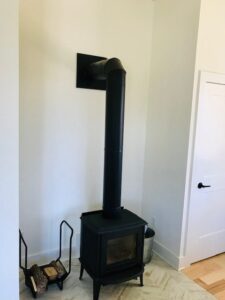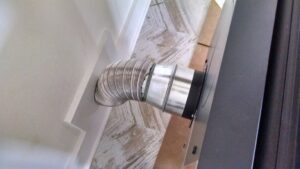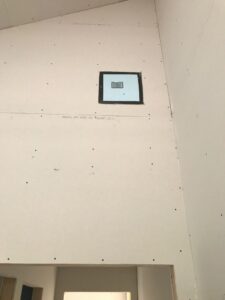We’ve written here before about the benefits of a green-building certification to homeowners for energy bills in particular, such as the assurance that your builder is following many of the best practices known to building science, or that common issues that cause high energy bills are caught by a professional.
Yet energy efficiency is not the only benefit of green building, and it may not even be the most important one to many homeowners. In many ways, using building science knowledge to improve indoor air quality can have a far more profound impact on quality of life than home than measures that simply reduce energy use.
A Green Certification Focused on Air Quality
Indoor Air Plus is another voluntary, third party green building certification available for new construction, and is the only one that focuses exclusively on air quality best practices. Indoor Air Plus is not as famous or as widely used as its sibling, Energy Star for Homes—which is a shame, considering the number of people concerned about the health of their home. As of right now, the program boasts a little over 14,000 homes certified in the US.
We recently undertook Indoor Air Plus Certification on a project, as part of our larger goal of building the first DOE Zero Energy Ready Home in our area. (The Zero Energy Ready Home program is one of the most advanced green programs put out by the EPA, and requires both Energy Star and Indoor Air Plus as pre-requisites.) We found that there are several key ways that an IndoorAirPlus certified home goes above and beyond the air quality requirements you might find in any other green building program.
Considerable Overlap with Energy Star and Green Built
By design, much of the requirements overlap with those in Energy Star for Homes or Green Built Homes, which require or reward heating, cooling, and ventilation systems that are properly designed using engineering standards. This overlap makes perfect sense, as a cooling system that’s properly sized saves energy but also gains a better control on interior humidity levels, which is critical in order to avoid a host of moisture and health related problems. Energy Star and Green Built already require mechanical fresh air ventilation, one of the key bedrock principles for indoor air quality in an air-tight home (air-tightness also being a tested feature of an Energy Star Home.) A number of key provisions for exterior moisture durability required by Indoor Air Plus—roof drip edges, appropriate window flashing techniques to avoid leaks, proper foundation drainage and storm water management—are also already covered by Energy Star and Green Built.
Selections Matter

Where Indoor Air Plus goes further is in the materials selected for the home–and like other checklist systems, everything is required and nothing is optional for points. Nearly every building materials going into an Indoor Air Plus home must meet a relevant third party standard, either for moisture durability, reduced content, low emissions of VOCs or other toxic chemicals that can build up in homes—Volatile Organic Compounds, commonly called VOC, are a class of chemicals commonly used in glues, binders, upholstery, paints and stains, household cleaners, and other manufactured products, that evaporate easily into the air. These chemicals are known to cause respiratory irritation and headaches, and have been found to exist in concentrations ten times higher indoors than outdoors, according to the EPA).
Products containing any kind of composite wood (such as plywood, OSB, particle board, medium density fiberboard, engineered wood flooring) must meet one of several standards for low formaldehyde and VOC content, such as those imposed by the California Air Resources Board (CARB) Phase II, one of the strictest rules for VOC content in wood products in the country. Since composite wood can be found in all kinds of products from structural sheathing to trim, doors, cabinetry, and engineered hardwood flooring, practically any finish selection the homeowner made had to be researched for compliance. Meanwhile, any carpet or carpet pad, another historic source of high VOCs, must be vetted to comply with CRI’s Green Label program and may not be installed in high moisture areas such as kitchens or bathrooms. Lastly, interior paints and stains have to meet one of a number of different standards for low VOC content and avoidance of the use of other harmful chemicals.
The tricky part about all of these requirements is simply the keeping track of all the different standards that a product might need to meet in order to be used in an IAP home. The good news is, the building industry as a whole pays more attention to the air quality impacts of many of their products than it used to, and in our project we did not have to seek out difficult-to-find or especially expensive products in order to qualify. Every selection that our homeowners made just happened to meet one of the necessary standards, but the challenging part was tracking down the paperwork to prove it. Sometimes it took more than one phone call to various suppliers, escalating up the management chain, to get the answer and the associated paperwork to prove that the product did in fact meet the requirements. Very often the required standard was obscure enough that even a knowledgeable sales person for a product might not have heard of it. Builders should expect the selections process to take research. Happily, the IAP website has put together a product selections guide.
Radon Mitigation
Radon is a naturally occurring gas that can creep into your home from the soil it’s built upon and can build up in the indoor air of an enclosed building. Breathing in air containing radon gas can lead to lung cancer. In fact, radon is the second leading cause of lung cancer in the U.S., after smoking.
It is difficult to know what radon levels will be in your home ahead of time, but passive radon mitigation systems offer cheap insurance and can be turned to active systems after move in if radon levels test too high. They are much cheaper to install during construction than after construction, when more significant disruption of the foundation would be needed. While passive radon systems following EPA guidelines are an often recommended best practice across the country, they aren’t yet required by most local building codes. IAP, of course, requires a properly constructed passive radon system.
Particulate Matter Source Control
The single most damaging air pollutant to human health isn’t radon, it isn’t a VOC, and it isn’t even a chemical that comes from a building material at all. That superlative actually goes to class of air pollutants called particular matter, specifically “PM10” —particulate matter with a diameter of 10 microns or less, and “PM2.5”—with a diameter of 2.5 microns or less. These air pollutants are one of the key contributors to smog and reduced visibility. They also contribute to climate change and their health impacts are very significant. The small diameter makes it easy for these particles to get past of body’s defenses when you inhale, causing short and long term lung irritation. PM2.5 is small enough to penetrate deep into your blood stream where it is suspected to do all kinds of damage to your lungs, heart, and even brain functioning. Particulate matter is produced primarily from burning coal, fossil fuels, and especially wood. According to the World Health Association, PM2.5 has caused the largest drop in life expectancy around the world of any air pollutant.
While particulate matter is a huge problem in developing countries with lower air quality standards and a greater dependence on dirtier fuels for power and home cooking, many don’t think about the fact that the fireplaces and wood stoves in our own homes generate notable quantities of particulate matter. Meanwhile, air-tight construction creates a greater risk that an improperly designed fireplace or stove will have chronic problems with dumping smoke into the house. Indoor Air Plus thus requires outside air intakes for any wood burning appliance, and specifies that only those units tested by the EPA to produce reduced particulate matter can be used. While this does not eliminate wood fireplaces or wood stoves from IAP certified homes—something that I’ve seen firsthand would be a deal breaker to some clients who are attached to the idea of a fireplace—it does mean these products must be selected carefully from the EPA list, and specified with an outside air intake kit. Though in truth, those clients who are especially concerned about their health should consider skipping out on burning wood inside their home.


(left) This ordinary looking wood stove happens to be EPA Phase II approved for low particulate production, and (right) has a dedicated outside air intake, air-tight to the unit, that pulls combustion air from outside rather than the room.
Carbon Monoxide Detection and Source Control
Any combustion appliance: be it a gas or propane furnace, water heater, or fireplace, must be direct-vent, meaning it is sealed from indoor air and has reduced risk of backdrafting issues due to pressurization of the home. Gas or propane cooktops are allowed*, but must have proper exhaust, and carbon monoxide detectors must be installed in every sleeping area. Carbon monoxide is a dangerous bi-product of incomplete combustion, and can be present in any home that uses combustion appliances that are not working properly. It is odorless, colorless, and 430 people are still killed by carbon monoxide poisoning every year in the US.
*Although homes with gas stoves often have high indoor levels of Nitrogen Dioxide (NO2)— another respiratory irritant, an issue that can be improved by range ventilation, but not to the same degree as is accomplished simply by having an electric or induction range instead of a gas one.
Filtration, Dust Protection and Pre-Occupant Ventilation
While we were already incorporating MERV 6 filters into our HVAC system as required by Energy Star, which is able to filter out 35-49% of dust, mole spores, and particulates at 3 to 10 microns, Indoor Air Plus requires an upgrade to MERV 8 filtration, which can filter 70-85% of those pollutants. As a reminder, since Energy Star requires Manual J, make sure to incorporate the higher filtration into your Manual J to get best airflow. That’s why it’s great to pair these programs together.

Another requirement is to cover ducts during key stages of construction, to keep drywall dust and other pollutants from contaminating a clean duct system right off the bat. This was something our HVAC contractor was doing if the ducts were in the floor, but hadn’t been doing when they were in the ceiling, due to sequencing with drywall installers. We brought them some foam board to cover up the ducts and had to work with the drywall installers (sometimes checking after them) to make sure they didn’t cut the covers. It was new to multiple trades and that required diligent extra supervision, but if we do it on every job, hopefully they’ll get used to it.
Lastly, no matter how good you are at source control, some residential moisture, dust, are VOCs are inevitable in a typical construction project. In the case of VOCs, their volatile nature means that most of their off gassing occurs early in the product’s life, with emissions dropping drastically over time. For this reason, IAP requires a “pre-occupant flush”—a period of 48 hours prior to client move in with the ventilation system set to run on high. While the end of construction is usually a busy time since the client is, quite understandably, gunning to move in ASAP, this extra step is still required.
Details, Details, Details
Much of Indoor Air Plus certification is about keeping track of the tiny details, material selections, and building practices. For builders, the biggest challenge is likely to be finding documentation of the specs of any random product before someone on the jobsite goes out shopping for a one-off material. For homeowners, the challenge is also most likely to lie in the selections process, finding products that can prove they are certified and sticking to those—and letting go of products they want to use but that don’t meet the standards.
Since most indoor air quality problems are invisible, and some can be quite serious, having all of these third party guidelines is a great way to protect everyone from harm, relying on the research and guidance of organizations that have studied these problems in detail.
And maybe think twice before installing that wood stove.
Leigha Dickens is Green Building and Sustainability Manger at Deltec Homes.

